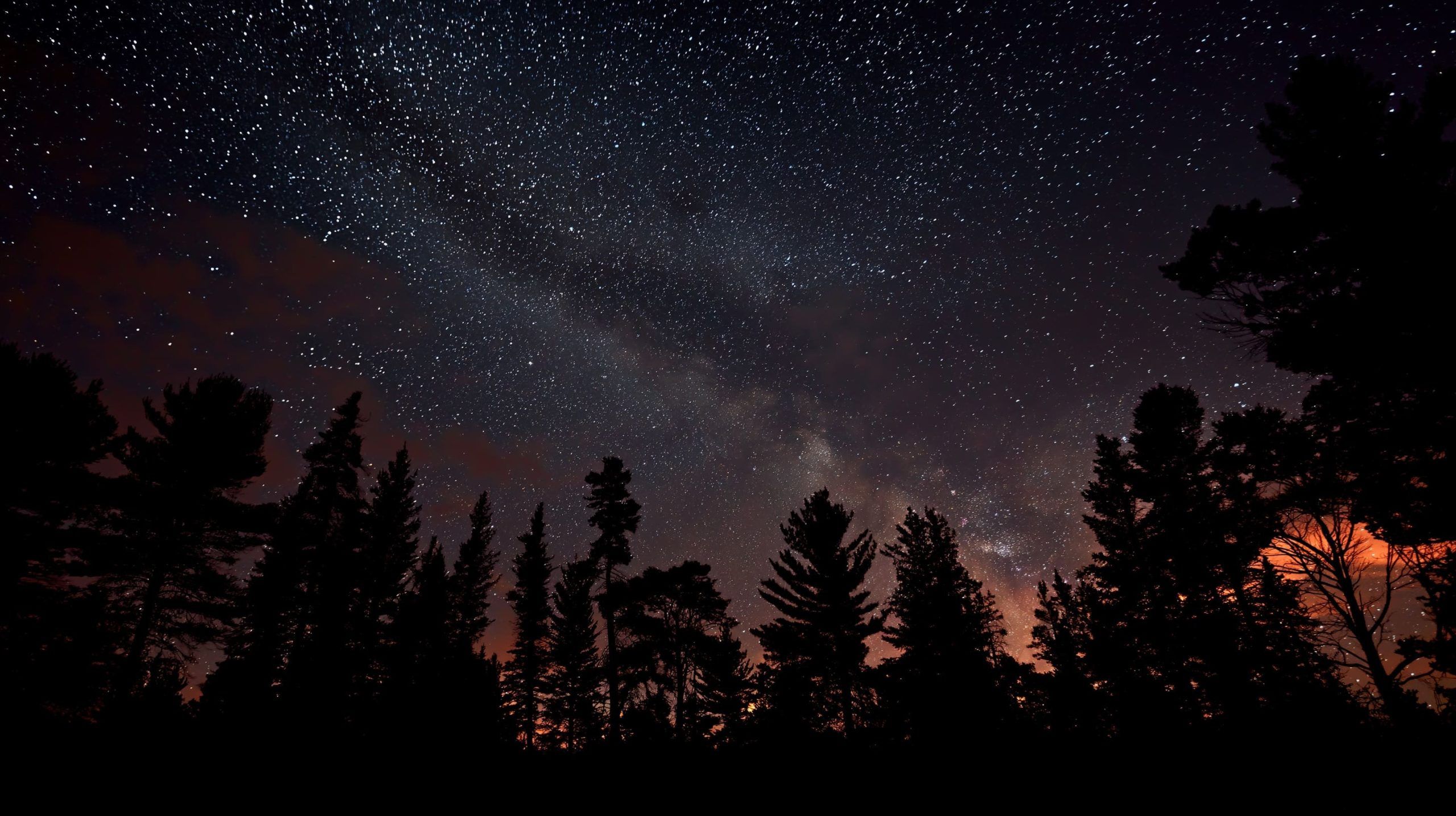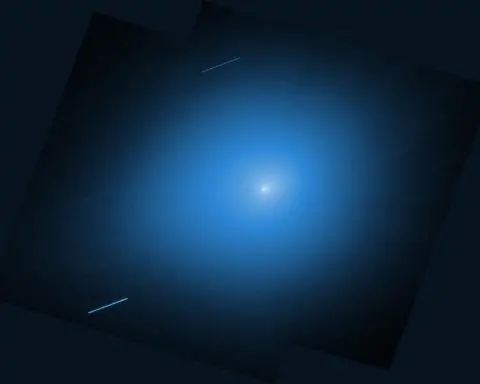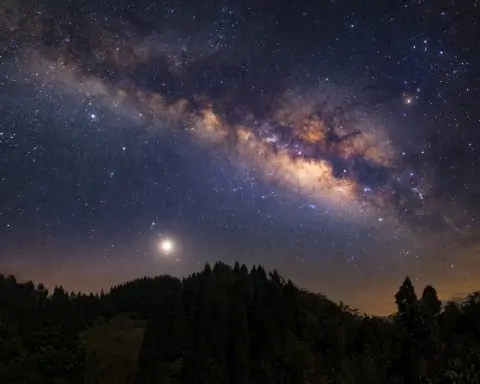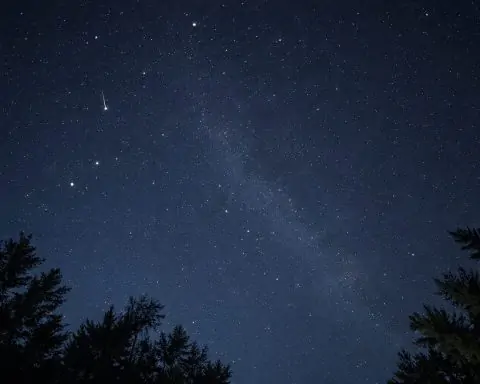- The Perseid meteor shower is active from mid-July to late August and is expected to peak around August 11–13 with up to about 100 meteors per hour under dark skies, though the full Sturgeon Moon on August 9 will brighten the sky and reduce counts to mostly the brightest fireballs.
- On August 4–5, the Moon is waxing gibbous at about 70–80% full, rising in the afternoon and setting in the pre-dawn, creating a darker window just before dawn for meteor watching.
- Observers could see roughly 10–20 meteors per hour in dark-sky conditions during late night to dawn on August 4–5.
- Venus and Jupiter form a dazzling dawn pair on August 4–5, with Venus at magnitude -4.0 and Jupiter at about -1.9, rising roughly 60–90 minutes before sunrise and about 7–8 degrees apart.
- The Venus–Jupiter conjunction tightens to about 1° apart around August 11–12, visible in the pre-dawn eastern sky.
- Saturn and Neptune appear extremely close in early August, culminating in an exact conjunction on August 6, with Neptune at magnitude about 7.8 and visible in the same low-power field with a telescope.
- Mars is near magnitude +1.6 in the constellation Virgo, fading and visible as a faint point low in the western sky after sunset around August 4–5.
- Mercury is not visible in early August, near superior conjunction with the Sun, and will re-emerge in the morning sky by mid-August, with its best morning apparition anticipated in late August.
- The International Space Station (ISS) is scheduled for visible passes in early August, often shortly after dusk over parts of North America and Europe, with passes lasting about 3–6 minutes and reaching magnitudes up to about -3.
- There are no solar or lunar eclipses on August 4–5, 2025, and no bright comets are expected then, with faint telescopic objects like C/2025 K1 (ATLAS) and 3I/ATLAS noted but not visible to casual observers.
Meteor Showers: Early Perseids Sparkle in Summer Skies
One of the most anticipated celestial highlights of August is the Perseid meteor shower, known for “bright blue meteors — and lots of them,” as astronomer Don Pollacco describes [1]. The Perseids are active from mid-July to late August and typically peak around August 11–13 with up to ~100 shooting stars per hour under dark skies [2]. NASA even calls the Perseids “the best meteor shower of the year” for their plentiful, fast, and vivid meteors [3]. However, 2025 is a challenging year for Perseid-watchers because moonlight will interfere during the peak. A full Sturgeon Moon on August 9 means the peak nights will have an 84–90% moon illuminating the sky, which “will brighten the sky and wash out the dimmer meteors,” experts warn [4]. In fact, the American Meteor Society notes the bright moon will “severely compromise” Perseid counts at maximum, leaving only the brightest fireballs visible [5]. The good news? Perseid meteors tend to include lots of fireballs – big, bright shooting stars that can shine through moonlight. “The Perseids result from bigger particles than a lot of other showers,” explains Bill Cooke of NASA’s Meteoroid Environment Office, which means more “bright fireballs” that are easier to spot even with some moonlight [6]. So while faint meteors will be washed out, a few spectacular Perseid fireballs could still blaze across the sky – each one a tiny fragment of Comet Swift–Tuttle burning up in Earth’s atmosphere [7].
What to expect on Aug 4–5: Even now, a week before the Perseid peak, the shower is ramping up. We’ve already “entered the Perseid meteor stream,” meaning you might catch Perseids “anytime now,” according to EarthSky [8]. Early August also sees an uptick in random “sporadic” meteors (the ones not part of any named shower) – roughly double the background rates of spring [9]. If you head out in the late night and watch between midnight and dawn, you could see on the order of 10–20 meteors per hour in dark-sky conditions [10]. This includes a mix of early Perseids and other stray shooting stars. The Moon is waxing gibbous (about 70–80% full) on August 4–5, rising in the afternoon and setting in the pre-dawn hours. That means there will be a window of darker skies just before dawn after moonset – the prime time for meteor spotting. Peak meteor activity is usually in the predawn hours, when the side of Earth you’re on is plowing headfirst into the meteor stream [11]. Plan to watch in the wee hours before sunrise on August 4–5 for your best chance to catch a few “shooting stars.”
Other meteor showers are also contributing a trickle of meteors. The Southern Delta Aquariids, which peaked at the end of July, are now tapering off; at their peak they produce around 10–20 meteors per hour [12], but by early August they’ll add only a few faint meteors, primarily seen from southern latitudes [13] [14]. Another minor shower, the Alpha Capricornids (peaked around July 29), is sparse in number but famous for slow, bright fireballs. You might spot an occasional Capricornid fireball in the first week of August – distinguishable by its slower speed and yellowish glow compared to the swift Perseids [15] [16]. In short, summer nights are rich with meteors from multiple sources. Don’t be surprised if even before the Perseid peak you catch a random streak of light or two; and if 2025’s display is a bit muted by moonlight, take heart that next year (2026) the Perseids will peak under a new moon for a truly stellar show [17] [18].
Viewing Tips: To maximize your meteor sightings:
- When to Watch: Plan for after local midnight until dawn on August 4–5. The Perseus constellation (where Perseid meteors originate) rises higher as the night deepens, so meteor rates improve in the early morning hours [19]. The darkest period will be just before dawn, especially once the Moon has set.
- Where to Look: Find the darkest sky you can, away from city lights (consider driving to a countryside spot or designated dark-sky park) [20] [21]. Lie back and gaze overhead – you don’t need binoculars or telescopes, as meteors streak across wide swaths of sky. If the Moon is still up, face away from it or use an object (like a building or trees) to block the moonlight from your eyes [22]. The Perseid meteors can appear anywhere, but if you focus about 45° away from the Perseus radiant, the meteors that do appear will have longer, more dramatic tails [23].
- Get Comfortable: Bring a lawn chair or blanket to lie on, and give your eyes ~30 minutes to adjust to the darkness [24]. Avoid checking your phone or any bright lights during this adjustment. Patience is key – meteors often come in spurts, with lulls in between.
- Best Locations: The Northern Hemisphere gets the best Perseid views, since Perseus climbs higher in northern skies. Observers in Europe, North America, and Asia will see more meteors (given clear dark conditions) than those in the far south [25]. Southern Hemisphere skywatchers can still catch Perseids, but at lower rates since the radiant stays nearer the horizon [26]. (The Delta Aquariids, by contrast, favor southern latitudes [27].) Wherever you are, a clear, dark sky is essential – try to escape light pollution and let the summer night envelop you.
Planets & Alignments: Dazzling Venus–Jupiter Duo, Saturn’s Conjunction, and More
While the meteors play out overhead, the planets are putting on a show of their own [28]. In fact, virtually every major planet is visible at some point during these August nights. Here’s what to look for on August 4–5:
- Mars (Evening Twilight): The Red Planet is just barely clinging to visibility after sunset. Mars is now quite distant and faint (around magnitude +1.6) [29], so it won’t jump out at you – but persistent observers might spot a ruddy point of light very low in the western sky during twilight. Around Aug 4–5, Mars is residing in the constellation Virgo, and it sets shortly after the sky gets fully dark [30]. You’ll need an unobstructed view toward the west and maybe binoculars to glimpse Mars in the bright twilight glow. Catch it quick after sunset if you want to see this diminishing ember of a planet before it disappears.
- Mercury (Hidden in Sun’s Glare): Mercury is not visible in early August, as it’s lost in the glare of the Sun. The innermost planet is near its superior conjunction (on the far side of the Sun) and will re-emerge in the morning sky by mid-August [31]. In fact, Mercury is slated to make its best morning apparition of the year in late August [32] – so if you’re a Mercury fan, stay tuned for the second half of the month. But on Aug 4–5, don’t expect to see Mercury; it’s still hiding too close to the Sun’s glow.
- Saturn (Late Night into Dawn):Saturn takes center stage late at night. The ringed planet is rising around 10:30 p.m. local time in early August [33]. By midnight, Saturn will be shining well above the eastern horizon in the constellation Pisces. At magnitude ~0.8 [34], Saturn is the brightest “star” in that region of sky (aside from the Moon). If you locate the faint outline of Pisces or the nearby asterism called the “Circlet,” Saturn will be the golden point of light not far away. This August, Saturn is nearing its opposition (when it’s brightest and visible all night, coming later in the month), so it’s an excellent time to observe it. Even a small telescope will reveal Saturn’s stunning rings. Fun fact: Saturn is currently undergoing a rare celestial meetup of its own – a conjunction with the distant planet Neptune. In early August, Saturn and Neptune appear extremely close together in the sky, culminating in an exact conjunction on August 6 [35]. Neptune is too faint to see with the naked eye (about magnitude 7.8) [36], but if you have a telescope, around Aug 4–6 you can catch Saturn and Neptune in the same low-power field of view [37]! Neptune will be a tiny blue-gray “speck” near Saturn [38]. It’s essentially a telescope-only event, but a cool one: seeing two planets ~2.7 billion miles apart align almost line-of-sight. If you don’t have a scope, you can still enjoy Saturn as it glows steadily all night, outshining nearby stars. (Saturn’s largest moon Titan is also visible in most backyard scopes; although the special Titan shadow transit event on Aug 2–3 has passed [39], Titan itself and other moons are always neat to observe if you have access to a telescope.)
- Venus & Jupiter (Dazzling Dawn Duo): The real “wow” moment for everyone – no telescope needed – is happening before sunrise, where the two brightest planets in our sky, Venus and Jupiter, are putting on a dazzling display. Step outside about 60–90 minutes before your local sunrise and look toward the east-northeast horizon. You’ll find brilliant Venus (magnitude –4.0) and bright Jupiter (around –1.9) rising in tandem, not far apart [40]. Venus is the intensely bright “Morning Star,” and Jupiter is a bit higher up and slightly dimmer (though still one of the brightest objects in the sky). By August 4–5, these two planets are drawing quite close – only about 7 or 8 degrees apart (roughly the width of your palm at arm’s length). They form a striking “double beacon” in the pre-dawn darkness [41], almost like a pair of cosmic headlights low on the horizon. Each morning, Venus and Jupiter creep nearer to each other. NASA notes that the two planets “appear to graze each other” around mid-August, coming into an ultra-close conjunction on August 11–12 when they’ll be just ~1° apart [42]. (That’s so close together on the sky that you could hide both behind your outstretched pinky finger! [43]) This Venus–Jupiter meetup is one of the highlight events of the month. Some skywatchers are joking that such a tight pairing might even fool casual observers into reporting “twin UFOs” hovering in the dawn [44]! So if you’re an early riser (or willing to become one for a day), don’t miss the spectacle in the east. It’s visible worldwide – anywhere the sky is clear and you have an unobstructed view toward the E/NE before sunrise [45]. The main challenge is that the planets are low on the horizon, so you’ll want to find a spot with a clear view (no tall buildings or trees blocking the east). Start looking around 4:00–5:00 a.m. local time (exact timing depends on your latitude and sunrise time) while the sky is still dark [46]. Venus will pop out first (it’s extremely bright), and Jupiter will be nearby. Binoculars can help you spot them in brightening twilight, but once you know where to look, they’re easily visible to the naked eye. This coming conjunction is special – Venus and Jupiter won’t be this close and well-placed again for some years [47], so take the opportunity to enjoy the view now and mark your calendar for the peak on Aug 11–12.
- The Moon: Don’t forget the Moon itself – it’s a prominent player in the sky these nights. On Aug 4–5 the Moon is a waxing gibbous, growing from about 75% to 85% illuminated as it marches toward full on August 9 (the “Sturgeon Moon”) [48]. You’ll see the Moon rise in the late afternoon or early evening and set in the very early morning hours. Its bright presence will dim the fainter stars, but it can be a beautiful sight in its own right. If you point binoculars at the Moon, you can trace the stark light/dark line (the terminator) and see craters and lunar seas etched in relief. In early August, the Moon is gliding through the constellations of Scorpius, Sagittarius, and Capricornus. (In fact, on Aug 3 the Moon had a super-close encounter with the red supergiant star Antares in Scorpius – even covering it for some observers in the far Southern Hemisphere [49]. By Aug 4–5 that event has passed, but it shows how dynamic the night sky can be from one night to the next.) As the Moon heads toward full, its proximity will also accentuate certain planet sightings – for instance, Saturn will appear not far from the almost-full Moon on Aug 9–11, a photogenic pairing in the night of the full Sturgeon Moon [50] [51]. For now, just be aware the Moon’s increasing brightness is a factor in all skywatching this week – plan around it when hunting faint objects, but take a moment to enjoy its glow as well.
Planet Viewing Tips:
- Jupiter & Venus: Find a flat eastern horizon (e.g. an open field or hilltop) for morning planet gazing. These planets will be low in the sky, so even a small hill or building could block them. Look roughly 45° to the left of where the Sun will rise [52] and start about an hour before sunrise. Venus will catch your eye first; Jupiter is to its upper right (for Northern Hemisphere observers). They don’t climb very high before dawn, so timing is key. Early dawn (while the sky is still dark) is best – around 4:30–5:00 AM for mid-northern latitudes, a bit later for southerners.
- Saturn: Saturn rises in the east by late evening. By midnight or later, it’s high enough for good viewing. If you have a small telescope or even steady binoculars, check out Saturn’s rings – they’re currently tilted at an angle that’s very apparent. You might also spot Titan (Saturn’s largest moon) as a faint point nearby. Saturn is due south in the early morning hours, which is usually the best time to observe it (since it’s higher in the sky, above the thicker atmospheric layer near the horizon).
- Mars: Try scanning the west shortly after sunset with binoculars to catch Mars before it sets. It will be faint, so don’t confuse it with nearby stars. Antares (a bright reddish star in Scorpius) is in the southwest at dusk and often mistaken for Mars – but Antares twinkles, whereas Mars will shine with a steadier light and will be closer to the horizon.
- General: A star chart or astronomy app can be handy for identifying the planets and constellations. All the naked-eye planets (Mercury, Venus, Mars, Jupiter, Saturn) roughly line up along the ecliptic path. In early August, Venus and Jupiter are morning stars, Mars is an evening straggler, and Saturn rules the late-night period. Enjoy the planetary parade one by one as the night progresses!
Aurora Borealis Outlook: Will the Northern Lights Dance?
Whenever solar activity is high, there’s a chance the aurora borealis (Northern Lights) might surprise skywatchers. 2025 is near the peak of the Sun’s 11-year cycle, so the Sun has been spitting out more flares and eruptions – which means we keep an eye on space weather forecasts for aurora alerts. At the very start of August we saw a small example: on Friday, Aug. 1, a minor geomagnetic disturbance (around Kp index 3) gave skywatchers in several northern U.S. states and Canada a chance to see the aurora [53]. NOAA’s Space Weather Prediction Center had actually forecast Kp 3 activity for that night, and indeed a gentle auroral display materialized in dark skies at high latitudes [54]. (For reference, the Kp index ranges from 0 to 9, and you typically need about Kp 5 or above for a geomagnetic storm that produces widespread auroras at mid-latitudes. Kp 3 is below official “storm” level, but it can still push the aurora slightly beyond the polar regions.) NOAA noted that a Kp 3 aurora can be “quite pleasing to look at” under perfect dark-sky conditions [55] – and it was! Some lucky observers as far south as northern Montana, Minnesota, Wisconsin, and upstate New York reported faint red and green glows on the horizon that night [56]. The Moon was only about half illuminated then, so its light didn’t interfere much with the dim auroral curtains [57].
Now, what about August 4–5? The aurora outlook for these nights appears quieter. According to NOAA’s 3-day space weather forecast going into this week, no G1-class (Minor) geomagnetic storms are expected for the first few days of August [58]. The Kp index is predicted to hover in the “unsettled” range (around 2 or 3 at most) [59]. In practical terms, that means Earth’s magnetic field should remain relatively calm, barring any unexpected solar outburst [60]. Without a stronger solar wind disturbance, the auroras will likely be confined to their usual polar zones. Northern Lights will probably be limited to high latitudes – think far northern Canada and Alaska, Iceland, Greenland, Scandinavia, or maybe northern Scotland – on nights like Aug 4–5 [61]. If you live in those aurora-prone regions, it’s always worth glancing north on any clear, dark night, just in case a delicate auroral arc is glowing low on the horizon. But for the vast majority of us farther south, the sky will not be lighting up with auroras under these predicted conditions [62] [63].
It’s important to add that space weather can surprise us. A sudden solar flare or earth-directed coronal mass ejection (CME) could occur and alter the forecast if it hits Earth a day or two later [64]. As of now (early Aug), the Sun hasn’t produced any major flares in the past few days [65]. So the short-term expectation is quiet, but one big solar eruption could change that – so avid aurora chasers keep an eye on alerts from NOAA, NASA, or services like Spaceweather. If you’re keen to catch the aurora and you live in a marginal area (say the northern U.S. or central Europe), you can sign up for aurora alerts or monitor Kp indices; but unless you live above roughly 55°–60° N latitude, you’re unlikely to see auroras around Aug 4–5 under the forecast conditions [66]. For those at lower latitudes, it’s better to enjoy the other celestial sights without expecting a green glow. And if you are in a northern locale where auroras occasionally reach, maximize your chances by finding dark skies away from city lights, and let your eyes fully dark-adapt (and of course, look north!). Also note, the Moon will be about 70–80% full on these nights – not as blinding as a full moon, but bright enough to affect the sky’s darkness. If by chance auroral activity does occur, that moonlight could dilute the contrast a bit. (During strong geomagnetic storms, auroras can still be visible even with a bright Moon or light pollution, but for weak auroras you want dark skies [67].) The bottom line: no major aurora displays are anticipated on Aug 4–5, but the unpredictable nature of the Sun means one should never say never. Keep watch if you’re far north, and otherwise look forward to later in the year – interestingly, late August and the equinox period often bring enhanced aurora activity and longer, darker nights. In fact, experts note that late August marks the return of a stronger-than-average aurora season for high-latitude destinations like Iceland and Greenland [68]. So as summer turns to fall, the Northern Lights odds will improve.
Expert insight: Space weather officials emphasize realism. As one NOAA space weather scientist put it in a recent briefing, “We don’t expect significant geomagnetic storming this week, but we’re always monitoring the Sun. It only takes one eruption pointed our way to light up the sky.” So, stay alert if you’re an aurora enthusiast, but enjoy the calm, starry nights if nothing materializes.
ISS and Satellite Flyovers: Man-Made “Stars” to Spot
Not all the bright moving lights in the night sky are natural – humanity has a fleet of satellites orbiting overhead, and spotting them can be a fun addition to your skywatching. The most impressive of these is the International Space Station (ISS), which regularly passes over and can be easily seen with the naked eye. In fact, the ISS is often the brightest object in the night sky after the Moon, thanks to its giant, light-reflecting solar panels [69]. To the eye, it appears as a steady, fast-moving star-like point of white light, usually taking about 3–6 minutes to traverse the sky from one horizon to the other. You won’t see any blinking lights (those are on planes) – the ISS shines with a constant brightness as it glides along, and it moves faster than a high airplane, crossing the sky in minutes rather than tens of minutes [70]. No telescope or binoculars are needed to enjoy an ISS flyover; even in many cities the station is bright enough to spot, because it’s essentially a 100-meter wide mirror reflecting sunlight down to us [71]!
When and where to see the ISS: The ISS orbits Earth about every 90 minutes (completing ~16 orbits per day) and flies roughly 51.6° north/south of the equator at its furthest reach [72]. This means it passes over most populated areas of the world, but not extreme polar regions. The station is only visible when it’s nighttime for you but the ISS is still catching sunlight – typically, that’s within a couple hours after sunset or before sunrise (when your sky is dark, but the ISS ~400 km high is illuminated by the Sun) [73]. These viewing windows come in cycles. In early August 2025, many locations in the mid-Northern Hemisphere (like much of Europe and the northern United States) are getting evening passes of the ISS shortly after dusk [74]. For example, around Aug 4–5, the ISS is making a series of visible passes in the early-to-mid evening over parts of North America and Europe – appearing in the west or northwest and crossing the sky to fade in the east. Further south (or a few weeks later), you might instead get pre-dawn sightings. The key is: it varies by location and date. To find out if and when the ISS will fly over your area on Aug 4–5, you should use an online tool or app. NASA’s “Spot the Station” website is a great resource [75]. You enter your city or coordinates, and it will list the upcoming ISS sighting opportunities, including what direction the station will appear, how high in the sky it will get, and how long it will be visible [76]. Many mobile apps (like Heavens-Above or various stargazing apps) also have ISS trackers. Once you have a time, simply go outside a few minutes before and look toward the listed direction. The ISS will appear as a bright, non-twinkling light moving steadily across the sky. If it’s a particularly good pass (high overhead and near the observer), the station can reach magnitude –3 or even brighter [77] – outshining all the stars and even rivaling Venus in brilliance. It’s quite a sight to realize that human astronauts are aboard that swiftly moving “star”!
If you happen to be watching the sky already (say, meteor gazing) during the correct time, you might catch the ISS by chance. It doesn’t blink, it doesn’t leave a trail, it just sails by silently. A typical pass lasts a few minutes from when the ISS rises above your local horizon to when it either sets or enters Earth’s shadow and vanishes. On some passes it will go right overhead; on others it might skirt the horizon. Check your local listings for Aug 4–5 – you might have an opportunity to wave (figuratively) at the astronauts passing by.
Other satellites: The night sky is filled with other satellites too. On any clear night after twilight, if you stay outside and watch, you’ll likely notice a few fainter moving pinpoints trekking across the stars [78]. These are usually much dimmer than the ISS (often requiring dark skies to notice), but some are notable:
- Starlink “trains”: SpaceX’s Starlink satellites often launch in batches, and shortly after launch they appear as a noticeable train of lights moving in formation [79]. This unusual sight has generated UFO reports from surprised people! Over time, the satellites spread out and become dimmer, but if a launch happened in the past few days, keep an eye out for a straight line of tiny dots moving together.
- Tiangong Space Station: China’s Tiangong space station is smaller and fainter than the ISS, but it can still be visible at times if the pass is favorable [80]. It requires a darker sky and often appears around magnitude 0 to +2 (so not as bright as the ISS’s negative magnitudes). If you’re an enthusiast, you can look up Tiangong pass predictions as well.
- Satellite Flares: Some older communication satellites (famously the Iridium satellites) can produce dramatic flares – sudden bright flashes in the sky – when their reflective panels catch the Sun at just the right angle. These flares only last a few seconds but can rival Venus in brightness. The Iridium satellites were mostly retired, but other satellites and spent rocket bodies occasionally produce flares too [81]. If you see a brief, bright flash that then fades out, you likely caught a satellite flare.
- General characteristics: Remember, satellites do not have blinking red/green lights (planes do), and satellites move with a steady speed across the star background. They also don’t leave trails (meteors do). Knowing these clues can help you distinguish an artificial satellite from an airplane or meteor.
Visibility and tracking:Anyone around the world can see satellites, but which ones and when depends on your latitude and the satellite’s orbit. For instance, the ISS never goes above 51.6° North, so observers in extreme-northern locations (far Scandinavia, etc.) won’t see it pass directly overhead [82]. But for the vast majority of populated areas – from ~50°N to 50°S – the ISS will be visible periodically. Major cities like New York, London, Tokyo, Sydney, and Warsaw all get the ISS flying overhead every few weeks during certain periods [83]. Satellites with polar orbits can be seen even closer to the poles. The best approach is to use a satellite tracking app or website to get predictions tailored to your location [84]. If there happens to have been a recent rocket launch, you might also get lucky and see something even more rare – sometimes, right after sunset, a rocket’s fuel dump or exhaust plume can form a ghostly glowing cloud in the high atmosphere. (None are known to be widely visible on Aug 4–5, but it’s a phenomenon to be aware of for future skywatching [85].) Overall, spending an hour under the night sky, you might be surprised by how many satellites you can spot. It’s a subtle reminder that we have a lot of “company” upstairs – a human footprint in space, quietly sailing above as we stargaze below.
No Eclipses or Comets to Worry About (and Debunking the “Darkness” Rumor)
What about eclipses, comets, or other rare celestial events on August 4–5? The short answer: none of note during these two days – apart from the meteor, planet, and aurora chances we’ve discussed. There are no solar or lunar eclipses occurring on August 4 or 5, 2025. (In fact, the next major eclipse near this date is a total solar eclipse on August 2, 2027, not 2025 [86].) You might have seen some viral internet rumors or sensational posts claiming that the world would experience a strange multi-day darkness or an eclipse in early August 2025 – rest assured, those are 100% fake. NASA and other authoritative sources have confirmed that no eclipse or global blackout is happening on those dates [87] [88]. August 4–5 will have the normal cycle of day and night; the Sun will set each evening as usual, and the only “shadow” over Earth will be the ordinary nightfall (plus maybe the shadow of Saturn’s moon Titan crossing Saturn, which we already covered!). So, don’t fall for any doomsday eclipse hoaxes – the only darkness this week will be the lovely natural dark of night that lets us stargaze.
As for comets, at the moment there aren’t any bright comets gracing the night sky that are easily visible to the casual observer. We occasionally get spectacular comets (like NEOWISE in 2020) that become naked-eye sensations, but none is expected for early August 2025. A few new comets are being tracked by astronomers – for example, comet C/2025 K1 (ATLAS) is out there, and there’s even an interstellar comet (3I/ATLAS) passing through the solar system – but these are telescopic objects, not something you’ll notice without serious equipment [89]. If you have a big telescope or follow dedicated astronomy news, you might seek out some of these faint fuzzies, but the general public isn’t missing a bright comet show at this time. (Later in 2025, there may be a couple of comets visible in binoculars or better – one source notes at least three comets might reach binocular visibility in 2025, including a potentially bright one in October [90] – but nothing of that sort is happening in early August.) So comet-wise, you can relax – there’s no rare Halley’s Comet or giant “green comet” up there this week that you’ll kick yourself for missing. Just keep an ear out for astronomy news in case something changes; comets can sometimes surprise us!
Final Tips for Enjoying the August 4–5 Night Sky
These nights offer a little bit of everything for sky enthusiasts – from meteor flickers and planetary eye-candy to the possibility (however slim) of auroral glows, plus human-made satellites adding their own twists. To make the most of it, here are some practical skywatching tips for an enjoyable experience:
- Check the Weather: It sounds obvious, but clear skies are a must. A perfectly timed celestial event means nothing if clouds roll in. Check your local forecast and try to find a location with expected clear conditions. If one night is cloudy, try the next – the events we’ve described (meteors, planet alignments, etc.) will be similar on both Aug 4 and Aug 5.
- Find a Dark Location: Light pollution is the bane of stargazing. If you’re in a city or suburb, consider visiting a nearby dark-sky park or rural area for the best view [91]. Even a short drive out of town can dramatically improve how many stars (and meteors) you’ll see. Higher elevations or open fields away from streetlights are great choices. Allow time to get there safely before it gets fully dark.
- Gear and Comfort: You don’t need any fancy equipment for meteors, planets (bright ones), or satellites – just your eyes. However, bring things to stay comfortable: a reclining lawn chair or blanket so you can look up without neck strain, warm clothing layers or a light jacket (nights can get cool, even in August, depending on your region), and perhaps some bug spray if mosquitoes are an issue on summer nights. A thermos of your favorite beverage doesn’t hurt either! If you have binoculars, they can enhance views of the Moon’s craters, Jupiter’s moons, or even catch a comet or dim star cluster, but they’re optional.
- Timing is Everything: To recap timing – for meteors, late night to pre-dawn is best (after the Moon sets, ideally) [92]. For Venus and Jupiter, predawn (roughly 60–90 minutes before sunrise) is the window [93]. For Saturn, around midnight to the hours before dawn will show it highest in the sky. For the ISS, check those specific pass times (which often are in the first 2 hours after dusk or before dawn). Plan your night accordingly so you don’t miss the narrow windows for certain sights.
- Let Your Eyes Adapt: When you’re at your observing spot, try to minimize looking at any bright lights. It takes about 20–30 minutes for the human eye to reach full dark adaptation. That’s when you’ll start seeing the dimmest stars and any subtle aurora or faint meteors. Using a red flashlight (or a phone app’s red “night mode”) can help preserve night vision if you need to read a star chart or walk around. Avoid checking your phone screen repeatedly (or use a red filter on it) because that quick blast of white light will reset your night vision.
- Know What to Look For: Having an idea of which direction and what to expect will enhance your experience. For instance, if you know “Venus will be the insanely bright object in the east before sunrise” or “the ISS will appear at 9:15 PM from the southwest and travel to the northeast”, then you can be ready and avoid confusing planets for planes or satellites for stars. This guide (and the cited sources) can serve as your cheat sheet. Some people like to use mobile apps that overlay the sky and label objects – just be mindful of the screen brightness.
- Safety and Etiquette: If you go to a popular stargazing spot or dark-sky park, remember that others will likely be there for the darkness too. Avoid using bright white lights or flash photography. If driving, turn off your headlights when approaching the final parking area (if safe) and use parking lights. Keep noise to a respectful level – it’s a peaceful night out for everyone. And of course, be mindful of personal safety in remote areas: bring a friend if possible, let someone know where you’ll be, and carry a small first aid kit or other necessities if venturing far.
- Enjoy the Moment: Last but not least, take time to simply enjoy the night sky. Not every moment needs to be spent hunting a specific event. Some of the magic of stargazing is in the unexpected: a random meteor that blazes overhead when you least anticipate it, the call of an owl in the distance, or the sheer wonder of seeing the Milky Way band (if you’re under a truly dark sky). These two nights, the Milky Way’s core is high in the south after dusk, especially for those in mid-northern latitudes – a gorgeous sight on its own. Soak it all in!
In summary, the nights of August 4–5, 2025, have plenty in store. You can catch a sprinkling of Perseid meteors (and perhaps a spectacular fireball or two) streaking through the late-night sky [94]. In the hours before dawn, you’ll be treated to the brilliant pairing of Venus and Jupiter – a celestial duet that’s drawing closer each day en route to a close kiss next week [95]. Saturn stands guard through the night, with its rings awaiting anyone who points a telescope its way, and even a neighboring Neptune hiding in its glare for those up to the challenge [96] [97]. The Moon waxes gibbous, illuminating the summer landscape and reminding us that its full phase (and a famous name, the Sturgeon Moon) is just a few days away [98]. Aurora hunters will likely have to be content with knowing the auroras are quietly dancing near the poles this week – but not much farther – unless the Sun throws us a curveball [99] [100]. And as you relax under the stars, don’t forget to spot the ISS or other satellites that zip by; a quick flash or steady glider overhead might just be one of our human-made “stars” saying hello [101] [102].
With a bit of planning and a dash of luck, your night of skywatching on August 4–5 can be an awe-inspiring experience. “The first weekend of August 2025 is packed with celestial sights,” one astronomy writer noted [103] – and that magic certainly continues into the following nights. So gather some friends or family, step outside, and look up! The universe has set the stage: meteors will play peekaboo, planets will shimmer and align, and who knows – you might even catch a faint auroral glow or the wink of the ISS. Clear skies and happy skywatching!
Sources: NASA (What’s Up August 2025) [104] [105]; American Meteor Society [106]; EarthSky [107]; NOAA Space Weather Center via SWPC [108]; TS2 Space Astronomy reports (August 2025 skywatch alerts) [109] [110] [111]; Space.com [112]; Royal Museums Greenwich/Travel+Leisure [113] [114]; People Magazine (NOAA aurora commentary) [115]; Local12 news (astronomer quotes) [116] [117]; Universe Magazine [118]; and more. All information is up-to-date for early August 2025. Enjoy the show!
References
1. ts2.tech, 2. ts2.tech, 3. ts2.tech, 4. ts2.tech, 5. ts2.tech, 6. ts2.tech, 7. ts2.tech, 8. earthsky.org, 9. ts2.tech, 10. ts2.tech, 11. ts2.tech, 12. ts2.tech, 13. ts2.tech, 14. ts2.tech, 15. ts2.tech, 16. ts2.tech, 17. ts2.tech, 18. ts2.tech, 19. earthsky.org, 20. ts2.tech, 21. www.travelandleisure.com, 22. ts2.tech, 23. ts2.tech, 24. ts2.tech, 25. ts2.tech, 26. ts2.tech, 27. ts2.tech, 28. ts2.tech, 29. ts2.tech, 30. ts2.tech, 31. ts2.tech, 32. ts2.tech, 33. ts2.tech, 34. ts2.tech, 35. ts2.tech, 36. ts2.tech, 37. ts2.tech, 38. ts2.tech, 39. ts2.tech, 40. ts2.tech, 41. ts2.tech, 42. ts2.tech, 43. ts2.tech, 44. ts2.tech, 45. ts2.tech, 46. ts2.tech, 47. ts2.tech, 48. www.travelandleisure.com, 49. ts2.tech, 50. www.travelandleisure.com, 51. www.travelandleisure.com, 52. ts2.tech, 53. ts2.tech, 54. ts2.tech, 55. ts2.tech, 56. ts2.tech, 57. ts2.tech, 58. ts2.tech, 59. ts2.tech, 60. ts2.tech, 61. ts2.tech, 62. ts2.tech, 63. ts2.tech, 64. ts2.tech, 65. ts2.tech, 66. ts2.tech, 67. ts2.tech, 68. www.travelandleisure.com, 69. ts2.tech, 70. ts2.tech, 71. ts2.tech, 72. ts2.tech, 73. ts2.tech, 74. ts2.tech, 75. ts2.tech, 76. ts2.tech, 77. ts2.tech, 78. ts2.tech, 79. ts2.tech, 80. ts2.tech, 81. ts2.tech, 82. ts2.tech, 83. ts2.tech, 84. ts2.tech, 85. ts2.tech, 86. ts2.tech, 87. ts2.tech, 88. ts2.tech, 89. www.youtube.com, 90. starwalk.space, 91. www.travelandleisure.com, 92. ts2.tech, 93. ts2.tech, 94. ts2.tech, 95. ts2.tech, 96. ts2.tech, 97. ts2.tech, 98. www.travelandleisure.com, 99. ts2.tech, 100. ts2.tech, 101. ts2.tech, 102. ts2.tech, 103. ts2.tech, 104. science.nasa.gov, 105. science.nasa.gov, 106. ts2.tech, 107. earthsky.org, 108. ts2.tech, 109. ts2.tech, 110. ts2.tech, 111. ts2.tech, 112. ts2.tech, 113. www.travelandleisure.com, 114. www.travelandleisure.com, 115. ts2.tech, 116. ts2.tech, 117. ts2.tech, 118. ts2.tech










